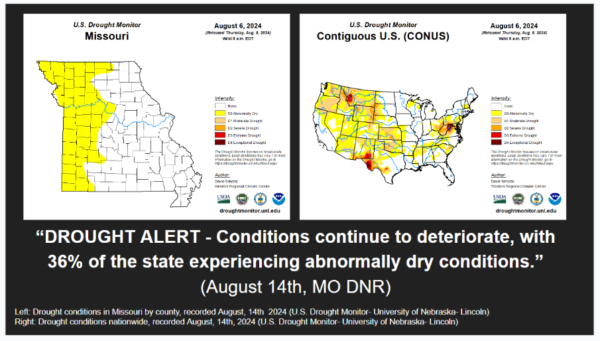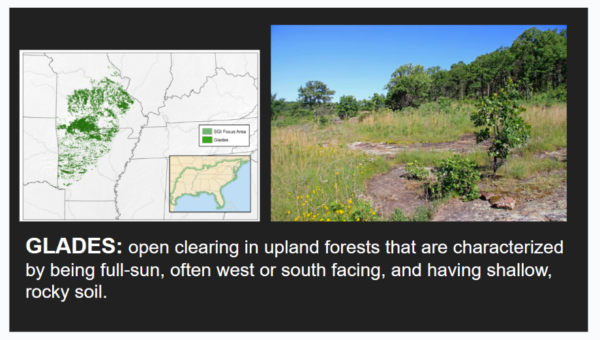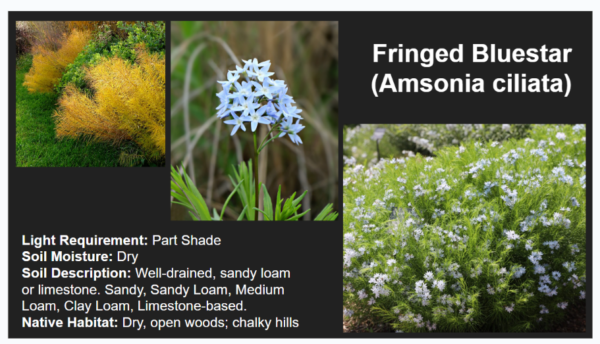by Erin Goss, Chapter member and Native Plant Initiative Coordinator for Shaw Nature Reserve
In August, we were joined by Conservation Ecologist, Shannon Callahan, with Bring Conservation Home, who shared with the class the importance of planting with the prospect of drought in mind. Many remember the summer of 2012 when the St. Louis Region was in the throes of an extreme drought with parts of southern and western Missouri experiencing exceptional drought conditions. Shannon shared comments from an EPA report titled What Climate Change Means for Missouri (Aug. 2016):
“The drought of 2012 narrowed navigation channels, forced lock closures, and caused dozens of barges to run aground on the Mississippi River along the Missouri shoreline. The resulting impact on navigation cost the region more than $275 million. The drought of 2012–2013 also threatened municipal and industrial water users along the Missouri River.”
With the deluge of water lately, you might be thinking “2012 was a fluke, right? We’ve plenty of water!” With climate change, we are seeing an increase in the severity and intensity of rainstorms. Instead of soft rain for hours on end – the kind of rain that infiltrates and filters down to our aquifers and recharges groundwater – we need to prepare for downpours, run-off, and flash floods. These intense rain events can flush nutrients out of the soil and sometimes, depending on the landscape, run off entirely without penetrating the ground at all, and overtake storm drains creating potential health hazards like backed up sewers and isolated flooding. As our spring and fall storms grow more intense, our summers will see fewer rain clouds. For those of us lucky enough to have heavy clay (it’s okay, roll those eyes!) our August soil will be parched, cracked, and impossible to dig. And plants that once tolerated a spot of drought will face the prospect of potential drought for months on end. Shannon asks us to look to nature to find inspiration – to glade systems and upland woodland habitats and their richness of drought-tolerant plant species.
Perennial plants to consider include purple poppy mallow (Callirhoe involucrata), with its giant taproot; spring-blooming phloxes like sand phlox (Phlox bifida) and downy phlox (Phlox pilosa); the ever-blooming and daughter plant-giving, lanceleaf coreopsis (Coreopsis lanceolata); the edible fall glade onion (Allium stellatum); and butterscotch fall –colored threadleaf bluestar (Amsonia ciliata). And don’t forget Missouri’s succulents: the prickly pear (Opuntia humifusa) and fame flower (Phemeranthus calycinus). Both pair very well together – especially in containers! Additionally, woody species such sumacs (Rhus aromatica and Rhus glabra), lead plant (Amorpha canescens) and false indigo (Amorpha fruticosa), and ninebark (us opulifolius) are all drought resistance to some degree. There are so many more options – too many to list in this small posting.
For more information, check out the Missouri Department of Conservation’s information page on Missouri Glade Systems, Grow Native’s Rock Garden template, or visit one of Missouri’s phenomenal glades like Valley View Glades and Victoria Glades both in Jefferson County and Shaw Nature Reserve’s many small glades in Franklin County. Upland woodlands are commonly found around the St. Louis region and can be experienced at natural areas like Powder Valley Conservation Nature Center in St. Louis County, Don Robinson State Park in Franklin County, and many, many more.
Sign up for upcoming classes, space is limited
- Spots still remain for October’s Native Plant School class: Halloween Edition – Native Plants With A Wicked Side at Shaw Nature Reserve with instructors Emily Dunlap
- November’s first Native Plant School class: Acorn Flour and Hickory Syrup at Shaw Nature Reserve with instructors Dr. Kate Farley and Jen Sieradzki
- November’s second Native Plant School Class: Landscape Reconstruction at Shaw Nature Reserve with instructor Vivian Bouse is full but there is a wait list
You can sign up by clicking the hyperlink above or browse the full Missouri Botanical Garden class catalog. Hope to see you there!




